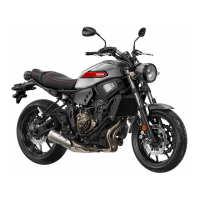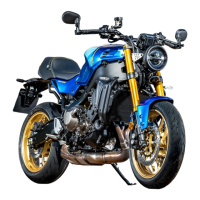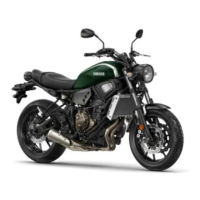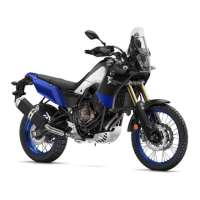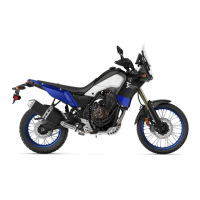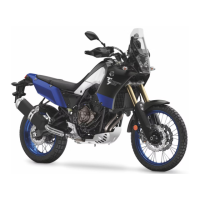Do you have a question about the Yamaha XSR 700 and is the answer not in the manual?
Guidelines for safe motorcycle operation and riding techniques.
Essential safety gear recommendations for riders.
Warnings about CO hazards and safe vehicle loading.
Safety considerations for aftermarket parts and modifications.
Guidance on aftermarket tires and safe vehicle transport.
Identification of components on the left side of the motorcycle.
Identification of components on the right side of the motorcycle.
Location and function of main controls and instruments.
Explanation of the vehicle's anti-theft immobilizer system.
Operation of the ignition and steering lock mechanism.
Meaning and function of dashboard indicator lights.
Information on the digital display including speedometer, tachometer, fuel meter.
Function of switches on left and right handlebars.
How to use the clutch lever for smooth operation.
Operation of the gear shift and rear brake pedals.
Explanation of the Anti-lock Brake System functionality.
Instructions for opening the fuel cap and safe refueling.
Procedures for removing/installing the seat and using the helmet cable.
Proper use and function of the motorcycle's sidestand.
Details on the system preventing starting without clutch/sidestand.
Key items to inspect before operating the vehicle.
Inspection points for operational components.
Verification of fasteners and electrical system operation.
Step-by-step guide to starting the motorcycle's engine.
How to change gears for optimal control and performance.
Techniques for smooth acceleration and deceleration.
Advice on how to improve fuel efficiency.
Recommended steps for breaking in a new engine.
Instructions for parking the motorcycle securely and safely.
Charts outlining required maintenance intervals based on mileage.
Procedures for checking and changing engine oil and filter.
Checking and maintaining the engine's coolant level.
Proper tire pressure, inspection, and replacement guidelines.
Checking brake fluid level and changing brake fluid.
Adjusting drive chain slack, cleaning, and lubricating it.
Procedures for checking steering and wheel bearings.
Information on battery care, charging, and storage.
Steps for identifying and replacing blown fuses.
Procedures for replacing headlight bulbs.
Steps for diagnosing and resolving common vehicle issues.
Steps to take if the engine overheats.
Warnings about cleaning methods and products.
Detailed steps for washing and drying the motorcycle.
Guidelines for storing the vehicle properly.
Steps for preparing the vehicle for extended storage.
Key physical measurements, weight, and engine specifications.
Details on tires, fuel capacity, and drivetrain gear ratios.
Specifications for brakes, suspension, and electrical system.
Location and importance of VIN, engine serial, and model labels.
Information on vehicle data collection and usage policy.
Guidelines for safe motorcycle operation and riding techniques.
Essential safety gear recommendations for riders.
Warnings about CO hazards and safe vehicle loading.
Safety considerations for aftermarket parts and modifications.
Guidance on aftermarket tires and safe vehicle transport.
Identification of components on the left side of the motorcycle.
Identification of components on the right side of the motorcycle.
Location and function of main controls and instruments.
Explanation of the vehicle's anti-theft immobilizer system.
Operation of the ignition and steering lock mechanism.
Meaning and function of dashboard indicator lights.
Information on the digital display including speedometer, tachometer, fuel meter.
Function of switches on left and right handlebars.
How to use the clutch lever for smooth operation.
Operation of the gear shift and rear brake pedals.
Explanation of the Anti-lock Brake System functionality.
Instructions for opening the fuel cap and safe refueling.
Procedures for removing/installing the seat and using the helmet cable.
Proper use and function of the motorcycle's sidestand.
Details on the system preventing starting without clutch/sidestand.
Key items to inspect before operating the vehicle.
Inspection points for operational components.
Verification of fasteners and electrical system operation.
Step-by-step guide to starting the motorcycle's engine.
How to change gears for optimal control and performance.
Techniques for smooth acceleration and deceleration.
Advice on how to improve fuel efficiency.
Recommended steps for breaking in a new engine.
Instructions for parking the motorcycle securely and safely.
Charts outlining required maintenance intervals based on mileage.
Procedures for checking and changing engine oil and filter.
Checking and maintaining the engine's coolant level.
Proper tire pressure, inspection, and replacement guidelines.
Checking brake fluid level and changing brake fluid.
Adjusting drive chain slack, cleaning, and lubricating it.
Procedures for checking steering and wheel bearings.
Information on battery care, charging, and storage.
Steps for identifying and replacing blown fuses.
Procedures for replacing headlight bulbs.
Steps for diagnosing and resolving common vehicle issues.
Steps to take if the engine overheats.
Warnings about cleaning methods and products.
Detailed steps for washing and drying the motorcycle.
Guidelines for storing the vehicle properly.
Steps for preparing the vehicle for extended storage.
Key physical measurements, weight, and engine specifications.
Details on tires, fuel capacity, and drivetrain gear ratios.
Specifications for brakes, suspension, and electrical system.
Location and importance of VIN, engine serial, and model labels.
Information on vehicle data collection and usage policy.
| Displacement | 689 cc |
|---|---|
| Bore x Stroke | 80.0 mm x 68.6 mm |
| Compression Ratio | 11.5:1 |
| Maximum Power | 54.0 kW (73.4 PS) @ 9, 000 rpm |
| Maximum Torque | 68.0 Nm (6.9 kg-m) @ 6, 500 rpm |
| Fuel System | Fuel Injection |
| Starter System | Electric |
| Transmission | Constant mesh, 6-speed |
| Final Drive | Chain |
| Frame | Diamond |
| Front Suspension | Telescopic forks |
| Rear Suspension | Swingarm, (link suspension) |
| Rear Brake | Hydraulic single disc, Ø245 mm |
| Front Tire | 120/70 ZR17M/C (58W) |
| Rear Tire | 180/55 ZR17M/C (73W) |
| Overall Length | 2, 075 mm |
| Overall Width | 820 mm |
| Overall Height | 1, 130 mm |
| Seat Height | 835 mm |
| Wheelbase | 1, 405 mm |
| Minimum Ground Clearance | 140 mm |
| Wet Weight | 186 kg |
| Fuel Tank Capacity | 14 L |
| Oil Tank Capacity | 3.0 L |
| Engine Type | Liquid-cooled, 4-stroke, DOHC, 4-valves |
| Ignition System | TCI (Transistor Controlled Ignition) |
| Front Brake | Hydraulic dual disc, Ø 298 mm |
